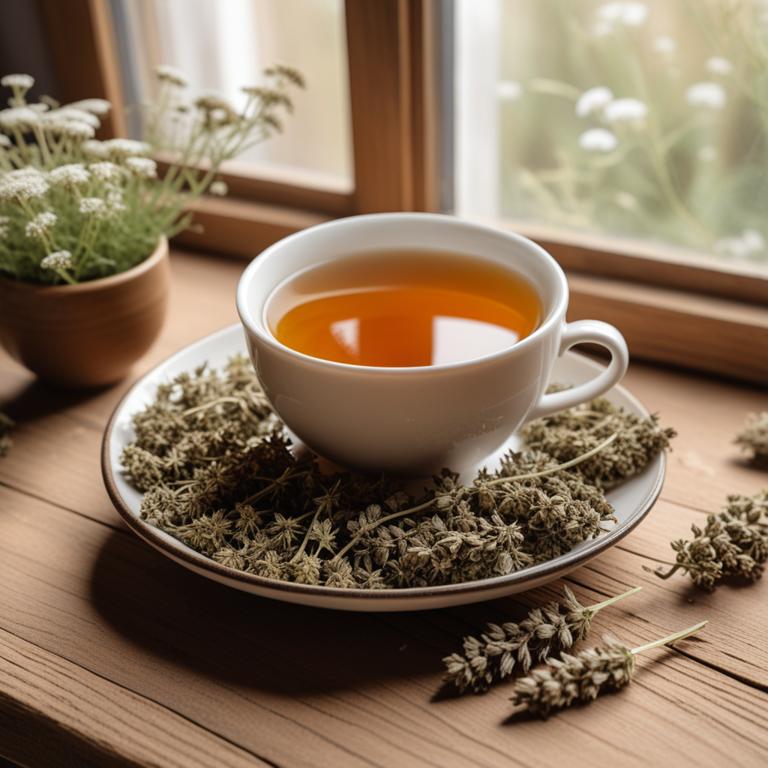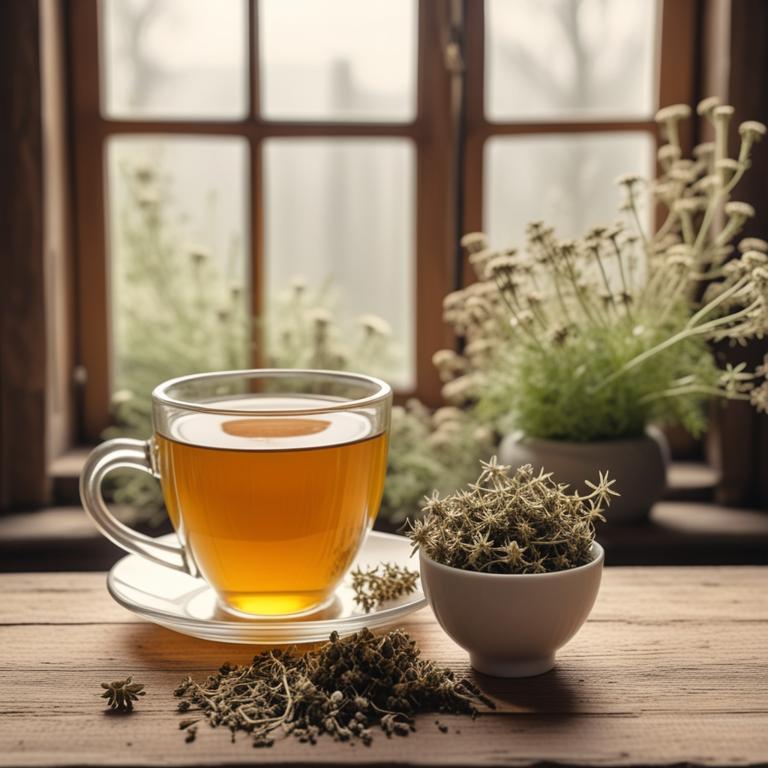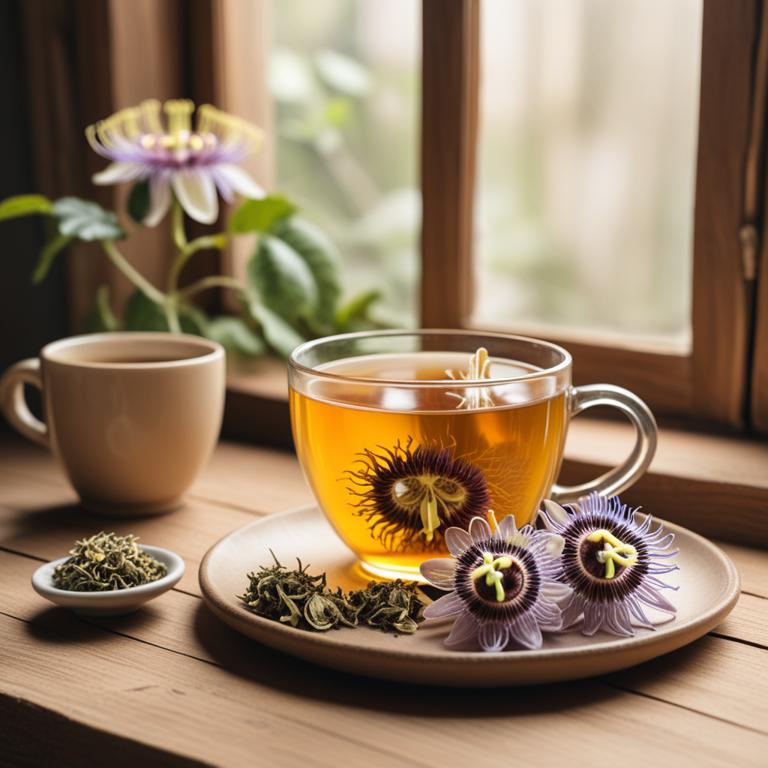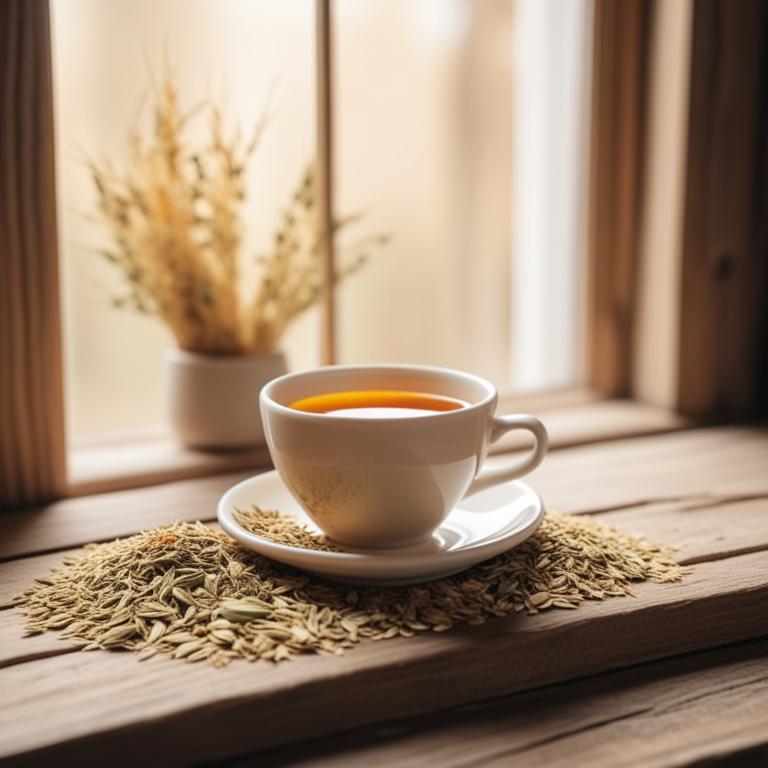7 Best Herbal Teas For Anxiety

Herbal teas for Anxiety are a type of herbal remedy that has been used to treat anxiety and promote relaxation.
They can treat anxiety by interacting with the body's natural neurotransmitters, such as serotonin and GABA, to calm the mind and body.
Examples of herbal teas that are commonly used to treat anxiety include chamomile, which has a soothing effect due to its high concentration of apigenin, a natural relaxant; lavender, which calms the nervous system and promotes relaxation; passionflower, which has a sedative effect; lemon balm, which has a calming effect on the nervous system; and valerian root, which is known for its ability to promote deep sleep and relaxation.
Additionally, other herbal teas such as peppermint, ginger, and ashwagandha are also used to treat anxiety due to their ability to reduce stress and promote relaxation.
Related Study
According to "Phytomedicine : international journal of phytotherapy and phytopharmacology", teas for anxiety that have been shown to have anxiolytic effects in humans include those made from Piper methysticum and Bacopa monniera.
Below there's a list of the 7 best herbal teas for anxiety.
Table of Contents
Also, you may be interested in...
Today Free Bonus!
The Ultimate Herb Drying Checklist
(For Long-Lasting Powerful Medicinal Effect)
How to easily dry herbs that don't mold and that keep their strong medicinal power for more than 1 year.
1. Valeriana officinalis teas

Valeriana officinalis teas, also known as valerian root tea, have been used for centuries to treat anxiety due to their sedative and calming properties.
The valerenic acid and valeranone present in this herbal preparation help to reduce anxiety by acting on the GABA receptors in the brain, promoting relaxation and reducing stress levels.
The bioactive constituents of valerian root tea, including valerenic acid, valeranone, and isovaleric acid, contribute to its anxiolytic effects by modulating the neurotransmitter activity and enhancing the GABAergic system.
Regular consumption of valerian root tea has been shown to provide benefits in reducing anxiety symptoms, improving sleep quality, and promoting overall well-being.
Related Study
According to the study, Valeriana officinalis teas for anxiety exhibit anxiolytic and sedative effects, representing one of the most thoroughly investigated medicinal plant materials with potential benefits in the treatment of fear and anxiety.
Recipe:
- Gather 1 teaspoon of dried Valeriana officinalis root and 1 cup of boiling water.
- Add the dried root to a tea infuser or a heat-resistant cup.
- Pour the boiling water over the root and let it steep for 5-7 minutes.
- Strain the tea into another cup and discard the root.
- Drink the tea 1-2 times a day, as needed, to help manage anxiety.
Valeriana officinalis teas can be used to treat anxiety, but possible side effects may include drowsiness, headaches, and stomach upset due to its sedative properties.
It is recommended to use Valeriana officinalis teas in moderation, avoiding excessive consumption, especially before driving or operating heavy machinery, and to be cautious when combining it with other sedatives or medications to treat anxiety.
Valeriana Officinalis Tea on Amazon
Frontier Co-op Cut and Sifted Valerian Root 1lb, Kosher - for Valerian Root Tea, DIY Supplement Capsules, Bedtime Formulas and Sleep Pillows
Disclaimer: We earn a commission if you click this link and make a purchase at no additional cost to you.
2. Melissa officinalis teas

Melissa officinalis teas, also known as lemon balm tea, have been traditionally used to treat anxiety due to their calming properties.
The herbal preparation helps to treat anxiety by promoting relaxation, reducing stress levels, and improving sleep quality.
The bioactive constituents of Melissa officinalis, such as rosmarinic acid and apigenin, contribute to its anxiolytic effects by interacting with GABA receptors and modulating the activity of neurotransmitters.
Regular consumption of Melissa officinalis teas has been shown to provide benefits in reducing anxiety symptoms, improving mood, and enhancing overall well-being.
Related Study
According to "Journal of ethnopharmacology", Melissa officinalis teas for anxiety have been shown to exhibit anxiolytic effects, which are attributed to mechanisms such as AChE inhibitory activity, stimulation of the acetylcholine and GABAA receptors, and inhibition of matrix metalloproteinase-2, as validated by modern pharmacological studies.
Recipe:
- Gather 1 cup of fresh Melissa officinalis leaves or 1 teaspoon of dried leaves.
- Steep the leaves in 1 cup of boiling water for 5-7 minutes.
- Strain the mixture and discard the leaves.
- Add honey or lemon to taste, if desired.
- Drink 1/2 cup of the tea 2-3 times a day as needed.
Melissa officinalis teas can be beneficial in treating anxiety, but it may cause side effects such as drowsiness, stomach upset, and interactions with certain medications.
To use Melissa officinalis teas safely, take them in moderation, avoid driving or operating heavy machinery, and be cautious when combining them with other herbal supplements or medications that have sedative effects.
Melissa Officinalis Tea on Amazon
Maxx Herb Lemon Balm Extract - Max Strength Liquid Tincture Absorbs Better Than Capsules or Tea, for Nervous System Support, & Stress Management - Alcohol Free - 4 Oz Bottle (60 Servings)
Disclaimer: We earn a commission if you click this link and make a purchase at no additional cost to you.
3. Lavandula angustifolia teas

Lavandula angustifolia teas have been traditionally used to treat anxiety due to their calming and soothing properties.
The herbal preparation contains bioactive constituents such as linalool and linalyl acetate, which have been shown to exhibit anxiolytic effects by modulating the activity of neurotransmitters like GABA and serotonin.
By promoting relaxation and reducing stress levels, Lavandula angustifolia teas help to alleviate anxiety symptoms, leading to improved sleep quality, reduced muscle tension, and enhanced overall well-being.
Regular consumption of Lavandula angustifolia teas has been associated with several benefits, including reduced anxiety ratings, improved mood, and increased feelings of calmness and relaxation.
Related Study
According to "Molecules (Basel, Switzerland)", Lavandula angustifolia teas may help relieve symptoms of mental stress and anxiety.
Recipe:
- Gather 1 cup of fresh Lavandula angustifolia flowers or 2 tablespoons of dried flowers.
- Boil 1 cup of water in a pot.
- Remove the pot from heat and add the Lavandula angustifolia flowers.
- Let the mixture steep for 5-7 minutes, then strain the tea into a cup.
- Add honey or lemon to taste, and drink 1-2 cups a day to help with anxiety.
Lavandula angustifolia teas can be an effective herbal remedy for anxiety relief, but possible side effects may include drowsiness, stomach upset, and allergic reactions in some individuals.
To minimize potential side effects, it is recommended to consume Lavandula angustifolia teas in moderation, avoiding excessive consumption, especially before driving or operating heavy machinery, and being cautious when combining with other sedatives or medications.
Lavandula Angustifolia Tea on Amazon
Tiesta Tea - Lavender Chamomile Herbal Tea | Loose Leaf | Calming Blend with Chamomile and Lavender | Caffeine-Free Herbal | Great for Hot or Iced Brews | Resealable Bulk Pouch, 200 Cups | 8 Ounce
Disclaimer: We earn a commission if you click this link and make a purchase at no additional cost to you.
4. Passiflora incarnata teas

Passiflora incarnata teas have been traditionally used to treat anxiety due to their calming and sedative properties, which help to reduce stress and promote relaxation.
The herbal preparation contains bioactive constituents such as flavonoids, alkaloids, and glycosides, particularly passiflorine, which are responsible for its anxiolytic effects.
By interacting with the brain's GABA receptors, these compounds help to regulate the body's response to stress, leading to a decrease in anxiety symptoms.
The benefits of Passiflora incarnata teas in treating anxiety include reduced symptoms of anxiety, improved sleep quality, and enhanced mood stability, making it a popular natural remedy for individuals seeking alternative solutions to manage anxiety.
Related Study
According to "Current pharmaceutical biotechnology", Passiflora incarnata teas for anxiety showed one of the most positive results in clinical studies.
Recipe:
- Gather 1 cup of fresh Passiflora incarnata leaves and flowers, or 1 teaspoon of dried leaves and flowers.
- Heat 1 cup of water in a saucepan until it boils.
- Add the gathered Passiflora incarnata to the boiling water, then reduce heat to low.
- Let the mixture simmer for 10-15 minutes, then strain it into a cup.
- Drink the tea when it's still warm, or let it cool down to room temperature before consumption.
Passiflora incarnata teas can be an effective herbal remedy for anxiety, but it may cause side effects such as drowsiness, dizziness, and stomach upset in some individuals.
To safely use Passiflora incarnata teas, it is recommended to start with a low dose and gradually increase as needed, and to avoid consuming it in the afternoon or evening to minimize potential disruptions to sleep patterns.
Passiflora Incarnata Tea on Amazon
Traditional Medicinals Organic Nighty Night Tea, 16 Tea Bags (Pack of 1)
Disclaimer: We earn a commission if you click this link and make a purchase at no additional cost to you.
5. Avena sativa teas

Avena sativa teas, derived from the oat plant, have been traditionally used to treat anxiety due to their calming and soothing properties.
The bioactive constituents of Avena sativa, including avenacosides, avenanthramides, and beta-glucans, help to modulate the body's stress response and promote relaxation, thereby reducing anxiety symptoms.
These bioactive compounds interact with the body's GABA receptors, promoting a sense of calm and tranquility, and also exhibit antioxidant and anti-inflammatory properties.
The regular consumption of Avena sativa teas can lead to improved sleep quality, reduced stress levels, and enhanced overall well-being, making it a popular natural remedy for anxiety relief.
Recipe:
- Gather ingredients: 1 tablespoon of dried Avena sativa root, 1 cup of boiling water, and a tea infuser or strainer.
- Measure 1 tablespoon of dried Avena sativa root and place it in the tea infuser or strainer.
- Pour 1 cup of boiling water over the Avena sativa root in the infuser or strainer.
- Steep the tea for 5-7 minutes, then remove the infuser or strainer.
- Strain the tea into a cup and drink immediately. You can add honey or lemon to taste, if desired.
Avena sativa teas can be used to treat anxiety, but it may cause side effects such as drowsiness, stomach upset, and changes in blood pressure.
Precautions to take when using Avena sativa teas include using it in moderation, avoiding it before driving or operating heavy machinery, and being aware of its potential interactions with other medications, particularly those used to treat anxiety or sleep disorders.
Avena Sativa Tea on Amazon
4 oz. Oatstraw Tea Oat Straw Herb Tea Loose Leaf (Avena sativa L.) - 113g Oat Straw Herb Hierba de paja de avena
Disclaimer: We earn a commission if you click this link and make a purchase at no additional cost to you.
6. Ginkgo biloba teas

Ginkgo biloba teas have been traditionally used as a natural remedy to help alleviate anxiety and promote a sense of calmness.
The flavonoids and terpenoids present in Ginkgo biloba teas possess anti-inflammatory and antioxidant properties, which contribute to their anxiolytic effects by modulating the activity of neurotransmitters such as serotonin and GABA.
The bioactive constituents, including quercetin, kaempferol, and bilobalide, work synergistically to reduce anxiety levels and improve mood by enhancing the activity of the brain's neurotransmitters and promoting a balance in the body's stress response.
The benefits of consuming Ginkgo biloba teas for anxiety relief include improved sleep quality, reduced stress levels, and enhanced overall well-being.
Related Study
According to the current scientific evidence, Ginkgo biloba teas for anxiety have shown a positive effect in reducing anxiety under pathological conditions, although more advanced clinical research is needed to confirm their efficacy.
Recipe:
- Gather 1 tablespoon of dried Ginkgo biloba leaves, 1 cup of boiling water, and a tea infuser.
- Place the Ginkgo biloba leaves in the tea infuser.
- Pour 1 cup of boiling water over the leaves in the infuser.
- Steep the mixture for 5-7 minutes, then remove the infuser.
- Drink the tea and enjoy, or let it cool before refrigerating for later use.
Ginkgo biloba teas can help alleviate anxiety symptoms in some individuals, but it may also cause side effects such as dizziness, stomach upset, and headaches due to its potential interactions with medications or exacerbation of pre-existing conditions.
Precautions when using Ginkgo biloba teas include being cautious when driving or operating heavy machinery, as they may impair coordination and reaction time, and also avoiding taking them with sedatives or antidepressants to minimize the risk of adverse interactions.
Ginkgo Biloba Tea on Amazon
Tai Chi Think Sharp Energizing Tea (Ginseng Ginkgo Biloba) 12 Bags
Disclaimer: We earn a commission if you click this link and make a purchase at no additional cost to you.
7. Zingiber officinale teas

Zingiber officinale teas, derived from the rhizomes of the ginger plant, have been widely used to treat anxiety due to their unique properties and bioactive constituents.
The sedative and anti-inflammatory properties of these teas, particularly the presence of gingerols and shogaols, help to calm the nervous system and reduce feelings of anxiety and stress.
The bioactive constituents, such as 6-gingerol, have been shown to have a positive effect on GABA receptors, thereby reducing anxiety and promoting relaxation.
By consuming Zingiber officinale teas, individuals can experience the benefits of reduced anxiety, improved mood, and enhanced overall well-being.
Related Study
According to "Indian journal of experimental biology", Zingiber officinale teas, made from the extracts of ginger, have been shown to exhibit significant anxiolytic activity, meaning they can help reduce anxiety, in mice models, particularly at doses of 50 and 200 mg/kg.
Recipe:
- Gather 1 cup of boiling water, 1 teaspoon of Zingiber officinale powder, and a cup.
- Add 1 teaspoon of Zingiber officinale powder to the cup.
- Pour 1 cup of boiling water over the powder.
- Let the mixture steep for 5-7 minutes.
- Strain the tea and drink it slowly.
Zingiber officinale teas can be used to treat anxiety, but they may cause side effects such as stomach upset, nausea, and dizziness in some individuals.
To use Zingiber officinale teas safely, it is essential to start with a low dose, gradually increase as needed, and avoid consuming them on an empty stomach or before surgery, as they may exacerbate bleeding and interact with blood thinners.
Zingiber Officinale Tea on Amazon
FGO Organic Ginger Tea, 100 Count, Eco-Conscious Tea Bags, Caffeine Free, Packaging May Vary (Pack of 1)
Disclaimer: We earn a commission if you click this link and make a purchase at no additional cost to you.